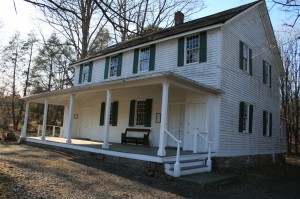The Establishment of Cornwall Monthly Meeting
The precinct of Cornwall was organized in 1764, and the first town meeting was held the following year. Built in 1790, the Meeting House is not only the first Quaker Meeting House in Orange County, but the oldest religious building of any faith in Cornwall. The story of how this came to be is, in large part, the story of David Sands. 
David Sands was the son of Presbyterian parents who had forfeited their home in Sandringham, England, to the Crown and had emigrated to the American colonies. In 1759, when David was 14 years old, the family moved again from Sands Point, Long Island, to the Hudson Valley. There they acquired property in the Queen Anne land grant extending from Storm King Mountain west to Firthcliffe.
By all accounts, David was (like George Fox before him) a young man of awkward religious anxiety. His initial attitude toward Quakerism was a distaste for the plain clothing and manners of its practitioners. His first recorded impression of seeing two Quakers in the street was: “It is impossible for me to be a Quaker; I would rather die.”
Young David nevertheless became friendly with a Quaker named Edward Hallock, of neighboring New Marlborough. Hallock, like the Sands, had relocated from Long Island, and encouraged David’s spiritual searchings. While traveling on business, Hallock introduced David to his first Friends Meeting at Liberty Street Meeting in New York City.
When David reached the age of 21 he requested and was received into membership in Nine Partners Meeting across the Hudson River in Dutchess County. A year after marrying Edward Hallock’s daughter Clementine, under the care of the Nine Partners Meeting, David moved into his parents’ large home in Cornwall. This house is still standing, and is called the “Sands-Ring Home.” Hanging on the wall of the fellowship room in the Meeting House is a portrait of David Sands done in Wedgwood style by an English sculptor named Ellis, dated about 1800.
Sands traveled widely, ministering and preaching. However, the Sands-Ring Home was the seed of the Cornwall Meeting. David’s parents, as well as some of his siblings, soon joined David’s faith. On August 21, 1772, Nine Partners approved the following minute: “This meeting thinks proper to visit friends over the River and Consider whither or no it would be Best for them to hold a meeting.” Meeting for Worship at Cornwall first took place in the Sands-Ring House on April 16, 1773. Meetings thereafter were alternately held in New Marlborough.
By 1776 the number of Friends in the Cornwall and New Marlborough area had grown so great as to warrant separate, rather than alternate, meetings. In 1777 Cornwall became a “preparative” meeting and, on December 22, 1788, was established as a Monthly Meeting in its own right.
By this time the number of Quakers worshipping at the Sands-Ring House was clearly beyond its capacity, and the members (now swelled by more families from Long Island, including the Seamans, the Cockses and the Townsends) determined to raise 280 pounds for the purpose of purchasing land and building a Meeting House. In July 1789, a parcel of approximately 10.25 acres was deeded from Langford Thorn to Joseph Thorn (Langford’s son), Nicholas Townsend and William Titus, in trust for Cornwall Monthly Meeting. The land was improved by construction of the Meeting House and the accompanying horse sheds, the architectural details of which are described in a subsequent chapter of this pamphlet.
Legend has it that David Sands’ 12-year old daughter, Catherine, brought wrought-iron nails to the site of the construction from a smithy located in New Windsor, by riding there and back on horseback. Those nails may be plainly seen embedded in the exposed timbers on the second floor of the Meeting House. Six years later, Catherine was married to Elias Ring at the first of many weddings celebrated in the Meeting House.
Two minutes of note survive from the early years of Cornwall Meeting, both reflecting testimonies that have always sustained American Quakers. In April 1789, while hostilities of the American Revolution continued, a minute is entered: “paid for sufferings on account of our testimony against war, 35 [pounds].” And in April 1790 Cornwall Friends recorded their union with Friends’ abolitionist testimony: “No Negroes as slaves.”
A second worship group arose in nearby Smith’s Clove in 1790, and that Meeting House also still stands. Meetings were subsequently established in Newburgh Valley (1799), Paltz (1801), Kakiat (1809) and Blooming Grove (1812).